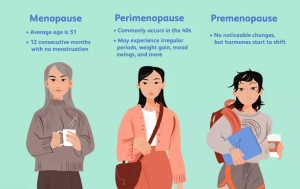Menopause is generally a natural process defined as the permanent end of menstruation. This definition is made 12 months after the final period. Menopause can also be triggered because of surgery such as a hysterectomy, or as a side effect from treatments such as cancer treatment as the ovaries stop producing oestrogen. Perimenopause is the initial stage of menopause which can see fluctuations in progesterone and oestrogen levels. This phase can last anywhere between 1 to 10 years, but on average takes approximately 4 to 6 years. During perimenopause, menstrual bleeds may become irregular, either less of more frequent, or be continually changing from period to period. Bleeds can also become heavier or lighter. Other symptoms such as hot flushes, disrupted sleep patterns, and mood disturbances can begin. Some may experience early onset menopause, which as where the final menstruation occurs before the age of 45, or premature menopause before the age of 40. These conditions can occur naturally, or because of surgery or pharmacotherapies.
Benefits of Exercise:
Exercise is one of the most indisputable things everyone should be doing for their health, and menopause is no exception. Exercise during (and after) menopause has numerous benefits:
- Reduce hot flushes and night sweats
- Alleviate psychological symptoms often seen such as depression, anxiety and impaired memory and concentration
- Reduce joint pain, headaches, and dizziness
- Aid incontinence
- Maintenance of bone mineral density and prevention of conditions such as osteoporosis and osteopenia
- Reduced risk of developing cardiovascular disease
- Improved endothelial function (reducing risk of atherosclerotic changes and high blood pressure)
- Improved insulin sensitivity (reducing risk of diabetes and issues with blood sugars)
- Improved quality of sleep
- Improved mental health and wellbeing
- Increased quality of life
- Improved weight management
These are on top of numerous other benefits for health in general such as decreased cardiovascular risk, improved metabolic profile, decreased falls risk, and ability to maintain independence as you age, just to name a few.
So, what should you be doing?
Well, in accordance with the Australian Physical Activity Guidelines, you should aim for 150-300 minutes of moderate intensity activity or 75-150 minutes of vigorous activity, or an equivalent combination of both. More specifically to those going through menopause, your exercise should include a combination of resistance, aerobic, power, balance, and pelvic floor training. There is a dose response relationship where the more you do, the more benefit you will get (up to a point). In saying that, if you are currently doing no exercise, there is no need to immediately start performing this amount of exercise, it should be a graded increase to achieving these goals. Research has also shown that completing exercise in a group class or with friends has been associated with further improvements in mental health, quality of life, and adherence to exercise.
Your program should also consider:
- Other chronic health conditions
- Current and previous injuries
- Exercise history
- Your goals
- What type of exercise you enjoy
Special considerations:
Before beginning an exercise program, all postmenopausal women should have a pelvic floor health check by a women’s health physiotherapist or Accredited Exercise Physiologist (such as our resident women’s health AEP, Megan), regardless of if you have had previous pregnancies, vaginal deliveries, or a hysterectomy. If pelvic floor dysfunction is suspected, exercise prescription should aim to minimise increases in intra-abdominal pressure and avoid strain being placed upon the pelvic floor to reduce the risk of pelvic organ prolapse or incontinence. If you already experience this, your exercise can still be made pelvic floor safe.




